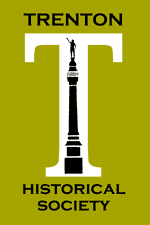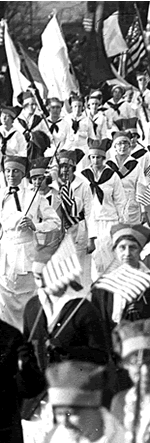
 Victory
Parade
Victory
Parade

 Victory
Parade
Victory
Parade
|
Preface TRENTON is perhaps best known to the American public as the scene of one of the most notable and brilliant events in the Way of Independence, the “turning-point,” as it has been called, in the fortunes of the Colonies in their contest with the mother country. In crossing the Delaware on Christmas night 1776 and in the successful surprise attack upon the Hessian troops in Trenton, Washington won a signal victory and established his claim to be regarded as a master of strategy. What is known as the “Second Battle of Trenton,” or the Battle of the Assunpink, fought a few days later on January 2, 1777, was perhaps even a more brilliant stroke of military genius, although strangely enough most historians have given this second battle but scant attention. But it is not only as the theatre of a conspicuous military exploit one hundred and fifty years ago that Trenton has a just claim to be regarded with interest. In Colonial days as subsequently it was an important link on the journey between the north and the south, the halfway house between the two great cities of New York and Philadelphia. Trenton early developed a brisk inter-state trade by road and river and was repeatedly visited by many distinguished persons whose names are household words in American history. Here the Continental Congress met in 1784 under the presidency of Richard Henry Lee and General Lafayette took formal leave of Congress. Here Washington in 1789 on the way to his inauguration as first President of the United States was accorded a brilliant reception by the citizens. Here the Federal Government in 1799 established its temporary seat and John Adams, the second President of the United States, lived for a period. In 1790 Trenton was made the capital of New Jersey and has thenceforth drawn within its precincts many eminent persons and has included among its citizens some of the foremost jurists and statesmen of the country. Perhaps not many are aware that Trenton in the middle 1780’s was seriously considered for the capital of the United .States and indeed came very nearly being chosen as such, finally yielding the distinction to the projected city on the Potomac as the result of political maneuvering and the expressed desire of Washington to secure that distinction for his own home land. John Fitch, a citizen of Trenton, the inventor of steam navigation and the first to make a practical test of its utility, backed by Trenton capital had in 1790 so far perfected his vessel that it successfully plied the waters of the Delaware and conveyed passengers between Trenton and Philadelphia. This was seventeen years before Robert Fulton with the Claremont did likewise on the Hudson. Several notable legal cases of far-reaching importance have been determined in Trenton, including the famous controversy in the closing years of the eighteenth century between the States of Pennsylvania and Connecticut which resulted in what is known as the “Trenton Decree,” and the “Goodyear Rubber Case” in the middle of the nineteenth century which was argued by Daniel Webster who had for his chief opponent Rufus Choate. Another Trenton case, “Hendrickson versus DeCow,” the decision in which determined the respective rights to corporate property as between the Orthodox and Hicksite Quakers, arising out of the schism in the Society of Friends in 1827 and involving certain novel juridical principles, is still cited today in courts of law. All these notable events of general historic importance are fully treated in these pages together with matters of more circumscribed and strictly local interest. In industry, particularly in the manufacture of American pottery which was here earliest organized and developed on a large scale and in wire-making and bridge-building as exemplified by the Roeblings, designers and builders of suspension bridges including the famous Brooklyn Bridge, Trenton was a pioneer and has been long and favorably known to the business world. Trenton manufacturers today send their wares to all markets at home and abroad and the city enjoys a corresponding degree of commercial prosperity. In view of the growth in these modern days of great cities, preeminent in industry and commerce, Trenton cannot attempt to claim a foremost place, but it nevertheless possesses a unique distinction of its own as presenting an example of an old American town. with an honorable past closely associated with events of the Colonial and Revolutionary eras and preserving today interesting features reminiscent of these periods. With the exception of Boston, New York and Philadelphia, probably there are few cities in the United States richer in historical lore than is Trenton. Its first permanent white settlement occurred in 1679; it existed as a mere hamlet during the last twenty-one years of the seventeenth century and gradually grew in size and importance during the eighteenth and nineteenth, until in this twentieth century it has become a large and flourishing city. A History of Trenton came about through the conviction of a group belonging to the Trenton Historical Society that the time was ripe for a fresh presentation of the subject, covering all phases of the city’s life and development from the earliest beginnings down to the present time. Though several excellent books by local authors are in existence, dealing with the general history of the city or with certain of its phases, there is yet no single work where the story is told in its fullness and the materials are coordinated and presented in a way calculated to interest and edify the general reader as also to satisfy the serious student. Moreover in recent years much valuable spade-work has been done by individuals, each working in his chosen field, whereby rich veins have been uncovered not hitherto rendered available to the local public. The immediate occasion which led to the production of this Book was a proposition made several years ago to sundry members of this group to undertake a history of Trenton in the interest of a publishing house which makes a business of producing town and county histories in connection with certain commercial and advertising features. The persons approached were unwilling to sponsor such a project, for the reason that it would seem to cheapen their authorship and compromise the dignity of the subject. Hence the offer was rejected and in association with others it was resolved to undertake the work free from the taint of commercialism or the exploitation of individuals. Public-minded citizens having pledged a guarantee fund sufficient to cover the expense of publication, the task was undertaken jointly on a voluntary basis and with no thought of personal compensation. As the members of the group are associated with the Trenton Historical Society it seemed fitting that the Book should be published under the auspices of the Society instead of going out unsponsored or merely bearing the names of the several authors. It was felt that the Society’s name would serve to add prestige to the work and be in direct line with its purposes and ideals. For several years past members of this group have been engaged in research and preparation along the line of the subjects severally assigned to them, but until recently little of a definite nature was accomplished. Under the spur of the significant fact that in the year 1929 Trenton will have completed two hundred and fifty years since its original settlement, it was determined, in recognition of that event, to bring the work to a completion. While each individual writer is alone responsible for the historical accuracy of the facts contained in his narrative, the editorial committee has yet used its best endeavors to verify the main statements by reference to the authorities and by comparison with the work of other writers in the group, and it is presumed that no glaring discrepancies will have found their way into the text. Whatever minor disagreements there may be are undoubtedly due to the influence of the personal equation which is an inevitable factor when phases of the same general subject are treated by different writers. For the same reason occasional duplication of matter has been unavoidable, though the endeavor has been made to reduce the repetitions to a minimum or at least to give them a supplementary aspect. A word may properly be said about the illustrations. In George A. Bradshaw, instructor in the School of Industrial Arts, Trenton possesses an artist whose pen-drawings and etchings have served to make his work favorably known beyond the confines of this locality. In selecting the subjects preference has been given mainly to buildings and scenes having an historical significance rather than to the modern and more pretentious ones at present in evidence. Portraits have been excluded, partly for the reason that those of the more prominent persons are elsewhere available, and partly because it was impossible to make a selection without seeming to be guilty of an invidious distinction. Acknowledgment of the cooperation in the preparation of this history freely rendered in many important ways by persons too numerous to mention, is here gratefully made. Especially are thanks due to Mr. Frank D. Halsey of the Princeton University Press, who has acted in an advisory capacity to the Editorial Committee, and to Miss Mary J. Messler of the Staff of the Free Public Library, who has made the Index and verified the Bibliography and the Chronology of Important Events. To the public-spirited citizens of Trenton who have generously provided the Guarantee Fund without which this work could not have been published, special gratitude is due, not only on the part of the Associated Historians, but also on the part of all who shall presumably profit by reading this history. FOR THE EDITORIAL COMMITTEE: EDWIN ROBERT WALKER HAMILTON SCHUYLER JOHN J. CLEARY JANUARY 1, 1929 |
Up To Top /
Home
The Society : About Us / Artifacts
Committee / Education Committee / Preservation
Committee / Membership / Contact
Us / Events
Our History : Sights & Sounds
/ 1929 History / Old
& New / Hill Diaries / Chronological
Indexes / Trenton Made / Documents
Your Ancestors : Research Services
/ Obituaries / City
Directories / High School Yearbooks /
Cemeteries / Genealogy
The City : Buildings /
Historic Districts / North
Ward Survey / Street Names / Local
Links
Search Our Site
Up
To Top / Home
The Society : Preservation
Committee / Artifacts Committee / Membership / Contact
Us / Events
Our History : Sights & Sounds / 1929
History / Old & New / Hill Diaries/ Chronological
Indexes / Trenton Made
Your Ancestors : Research Services / Obituaries / City
Directories / High School Yearbooks / Cemeteries
The City : Historic Districts / North
Ward Survey / Street Names / Local Links